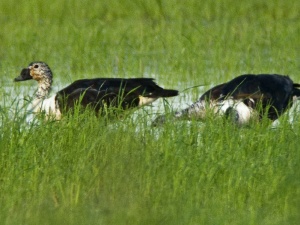- Sarkidiornis sylvicola
Alternative name: American Comb Duck
Identification
64–79 cm (25-31 in)
- Glossy blue black upperparts
- White underparts
- Blue and green iridescent secondaries
- White head with dark spots
- White neck
Male - larger with large black knob on the bill
Juvenile
- Dull buff underparts, face and neck
- Dull brown upperparts, crown and eyestripe
Distribution
Tropical South America (east of the Andes) to northern Argentina.
Has been reported as a vagrant on Trinidad.
Taxonomy
This is a monotypic species1.
Formerly considered conspecific with Knob-billed Duck from Africa and Asia.
Habitat
Wetlands, freshwater swamps, rice fields and lakes.
Behaviour
Diet
The diet for both subspecies is mostly vegetarian, with grass, seeds and rice grain; supplemented with small fish and invertebrates.
Breeding
They nest in tree holes and tall grass. The nest is lined with reeds, grass, or feathers. 7-15 yellowish-white eggs are laid; incubated by the female for about 30 days.
References
- Clements, J. F., T. S. Schulenberg, M. J. Iliff, D. Roberson, T. A. Fredericks, B. L. Sullivan, and C. L. Wood. 2018. The eBird/Clements checklist of birds of the world: v2018. Downloaded from http://www.birds.cornell.edu/clementschecklist/download/
- Hockey, PAR, WRJ Dean, and PG Ryan, eds. 2005. Roberts' Birds of Southern Africa. 7th ed. Cape Town: John Voelcker Bird Book Fund. ISBN 978-0620340533
- Handbook of the Birds of the World Alive (retrieved June 2015)
Recommended Citation
- BirdForum Opus contributors. (2025) Comb Duck. In: BirdForum, the forum for wild birds and birding. Retrieved 25 April 2025 from https://www.birdforum.net/opus/Comb_Duck






